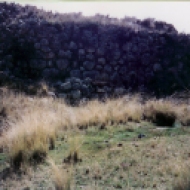Along the length of our territory, in the region of punas we find a series of reservoirs that because of their location we refer to them as part of the high altitude Andean grasslands.
During the years that we were appointed as the Technical Administration of the Irrigation District in Nepeña-Casma-Huarnay (Ancash), (2001-2004) we went over every inch of the basin that belonged to our territory. In Nepeña we were able to establish contact with people that had special interest in placing value on the Pre-Inca reservoirs that existed in the upper parts of the basins. They even spoke about their interest in a French organization to rediscover these important structures – Solidarite International is one of these.
This brought to our attention the need to evaluate the hydraulic potential in the upper parts of the basins in our area. From there, in October 2003, we organized a trip to the Basin of the Nepeña River in order to make recognize the conditions by which these structures were found. Additionally, we did a review of the documents and actions that had been carried out by other people. In this part we showed images of dammed lagoons with vestiges of walls built by our Pre-Inca ancestors, all of the ancestors that were located in the high part of the Basin of the Nepeña River in Ancash.
The basin of the Nepeña River is located to the north of Lima at its entrance on the 405th km on Pan-American Highway North. In order to arrive to the place where these lagoons are located, we got on a highway heading East, on the road toward Moro, where before arriving there you take a left and follow the road toward Jimbe, making an average time of approximately 4 to 5 hours of traveling in a truck with 4-wheel drive.
The above photo is taken from the Basin of Nepeña, on the black mountain chain. Towards the back we see the beautiful White Mountain chain, now in a vulnerable state facing the manifestation of climatic change that places much emphasis on our country.
In this collection of pictures we present Lake Carhuachocha, one of the lakes that had been “rehabilitated” in the years 2001-2002 by the efficient and committed work of the Father David Jhonson, a priest widely known throughout the populations of the Basin.
Climbing through Jimbe in Nepeña, we arrive to the Collpa Reservoir, one of the emblematic works of the basin that continues to produce water through the years that we were there. When we got close to Collpa, we were able to see an impotent wall made with clay and stone that to this day continues to produce a stream of water that stands out from afar and also indicated to us the work of hydraulic reinforcement that our ancestors fulfilled as an exhibition of care and planning.
For those of us that follow engineering, for the design of these structure we know that these rigorous steps and necessary checks are followed: to overturning, sliding, and efforts to make precise mathematical calculations to guarantee the functionality of these structures. Those of us who have seen the works are able to appreciate the level of care, of planning that they had to have had. Nobody makes such a huge effort in the transfer of materials without knowing what will result; they were definitely obedient to a planned effort and to the great knowledge of the basins.
In the previous pictures we can see the Saquicocha Reservoir and Negra Huacanan reservoir where the Pre-Inca damming is appreciated, which now gives great possibility to neighboring communities to have safe water, and above all, the outflows of filtrations that nourish the smaller water deposits located in the middle and lower parts of the basin.
When we climb up through these punas to get to the lakes we see beautiful countrysides, the principle river that is nourished by smaller and bigger, more affluent rivers that form the veins that give life. In these punas we also see typical vegetation of singular beauty that we show as a demonstration of the treasure that traverses this place.
















Good reaading